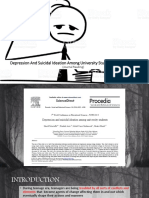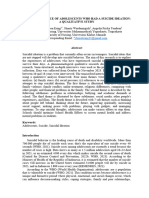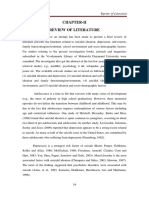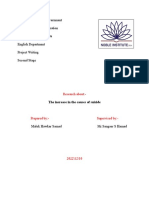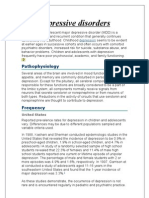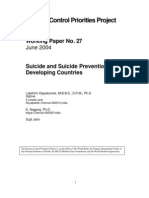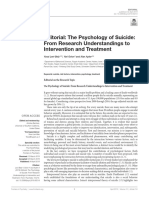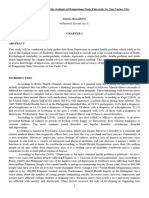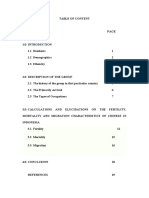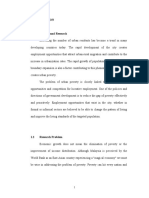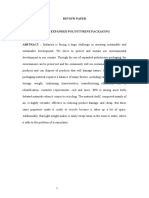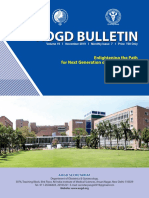JOURNAL ANALYSIS
The journal selected is a psychological journal titled "Psychological Factors as
Predictors of Suicidal Ideation among Adolescents in Malaysia" which has been
scientifically produced by Norhayati Ibrahim, Noh Amit and Melia Wong Yuin Suen.
This journal is available through https://doi.org/10.1371/journal.pone.0110670.
This article is about suicide cases in Malaysia from psychological aspects.
Symptoms of suicide among Malaysian societies are becoming increasingly common.
Almost every day there are stories that are exposed regardless of social media or
mainstream. Among the latest cases reported involving graduates in Bachok, Kelantan,
a man in Johor Bahru and a female student at a school in Penang. Obviously the
symptoms that occur regardless of this nation can no longer be underestimated.
Something should be done immediately to prevent it from spreading.
In general, suicides are also noticeable throughout the world. The latest World
Health Organization (WHO) report shows that nearly 800,000 people die of suicide
annually worldwide (one life every 40 seconds, the global suicide rate is 11 for every
100,000 population). It can happen at any time and is the second highest cause of
death for those between the ages of 15 and 29. It is even more frightening to estimate
that for every individual who suffers from suicide, there are 20 others who try to
commit suicide.
In Malaysia, a review by the National Suicide List Center 2009 shows suicide
rates are still low (1.18 per 100,000 population). The Indians had the highest rates
(3.67: 100,000), followed by Chinese (2.44: 100,000) and Malays (0.32: 100,000).
However, many experts think the actual numbers are much higher. It estimates, nearly
1
�2,500 suicides each year or on average seven cases per day. The same study notes that
hanging out the most popular way to commit suicide, followed by insect pesticides
and plunging from high places.
In Malaysia, committing suicide is a taboo and the topic is not openly discussed.
In recent years, the suicide rate has increased and appears to be an emerging social
problem in Malaysia. Indeed, statistics show that the suicidal rate has increased by
60% over the past 45 years and it is estimated that 140 people attempt suicide daily.
As seen globally, nearly 90 percent of people who commit suicide have mental
illness before the death and 60 percent of them suffer from depression. Although not
every patient with depression intends to commit suicide, many of them have long
been struggling with the problem. Women in general, are more often depressed than
men. Unfortunately, men have four times higher probability of taking their own lives,
when experiencing the same disorder.
Suicide not only causes significant loss in terms of productive human resources, it
also has a profound effect on abandoned family members. This is the most difficult
result of suicide. To make health workers and mental health practitioners especially,
suicide is a major complication in the majority of mental disorders. Psychiatrists are
often asked to see patients who are present for the failure of suicide attempts,
deliberately harming themselves and putting a desire to commit suicide with
depression and psychotic symptoms. This group consists of those who think about
suicide. Some of them really can not continue to live and want to end it. For those
who fail in suicide attempts, they will be asked about their intentions and their mental
health will be examined. Often, this process will be performed by health
professionals.
2
� Unfortunately, a handful of people may think this group is weak and more
unlucky, 'crazy'. Those who want to commit suicide are ridiculed, denied friends and
sometimes, laid off. Despite being overwhelmed, attempts to end their own life take
place every day and this is the reality that needs to be faced.
At this time, what is more alarming is the tendency of individuals to commit
suicidal or long-term intentions, especially when dealing with a crisis in everyday life.
Many reports indicate that it occurs when the individual fails or feels incapacitating to
deal with the stress or stress experienced such as financial problems, shame, breaks,
divorcees and so on. Perhaps the time comes, the skill of managing stress and problem
solving is an important component of national education. Such knowledge can help
individuals to cope with future expectations and challenges. Suicide is certainly no
longer an option if stress can be managed and handled effectively.
The Malaysian Psychiatric Association estimated that seven people, who mostly
comprise youth and young adults, are killing themselves daily. This is indeed a
shocking statistic. It implies that within 24 hours, seven lives are lost due to suicide.
According to the National Health and Morbidity Survey conducted by the
Ministry of Health Malaysia, 6.3% of the participants reported having suicide ideation.
In this survey, it was found that the youngest aged group – 16 to 19 years old – was
most disposed to suicidal thoughts followed by the 20 to 24 years age group. The
findings also showed that females reported higher suicidal ideation. However, there
was no difference between the urban and rural population concerning suicidal ideation.
In addition, the National Suicide Registry Malaysia (NSRM) estimated that between
January and August 2010, a total of 425 people had committed suicide. In addition, a
local study by Tam et al. reported that there were 445 suicide cases in Malaysia for
3
�the first eight months of 2010 compared to 290 cases in 2008. These figures were only
based on legal cases or cases reported to the police, indicating that there are still many
unreported cases.
Some of the major psychological factors associated with suicidal ideation are
depression, anxiety, and stress. Most of the findings on the relationship between
psychological factors and suicide as well as suicidal ideation are based on the
evidence of the psychological autopsy conducted among those who have committed
suicide.
Mental disorders are considered one of the most common causes of suicide. One
of the symptoms that occurs generally in various psychiatric conditions is feeling
depressed. These mental states include bipolar disorder, anxiety, depression and
schizophrenia. When you and your doctor strive to find a treatment that can
effectively treat your mental state, you may feel helpless and fear that you may never
feel normal again. You may feel the only way to end the pain is to end your life.
One of the psychological features of suicide in Malaysia is caused by depression.
It is a major contributor to suicide symptoms and suicide attempts. Additionally, teens
who feel themselves 'useless' are also indicative of suicidal symptoms. The depression
could be attributed to individuals' feelings of hopelessness, helplessness, and a lack of
social support and coping skills when they face difficulties and stressful life
experiences.
Another common risk factor for suicidal ideation is anxiety. Anxiety is one of the
most common psychiatric illnesses seen in general practice. Anxiety can cause fear in
your surroundings and prevent you from adapting to changes in life. In some cases,
4
�anxiety makes it difficult for you to maintain friendship, finish school, or retain your
work. So the combination of loneliness and fear triggers you to think about suicide.
Understanding the psychological factors is important for prevention and treatment
in relation to suicide among young people in a specific cultural context. This is
because by having a proper understanding about the risk of suicide among adolescents,
an appropriate assessment process will facilitate the appropriate treatment being given
to those who are at risk. This research has the potential to identify the proper support
and psychological needs for those who are having suicidal ideation and at risk of
suicide.
The findings show that there are moderate positive correlations between
depression, anxiety, stress, and suicidal ideation. The results suggest that the
respondents who reported high levels of depression tended to report high levels of
suicidal ideation.
From this article, the results indicate that only depression predicts suicidal
ideation. This suggests that depression could be regarded as one of the potential
predictors for suicidal ideation among adolescents. This means that those who feel
depressed may perceive themselves as lacking control over the situation and
persistently feeling defeated. In fact, their perception towards their current situation is
negative and overwhelming, and they tend to be preoccupied with a sense of guilt and
worthlessness. Therefore, depression could be a potential risk for suicidal ideation and
suicidal related behaviour among adolescents.
It is unfortunate that our country is attacked by mental patients such as stress,
anxiety, schizophrenia and bipolar because of such mental illness or other illness can
not cure it but can only be treated and controlled using medication and counseling.
5
�.






